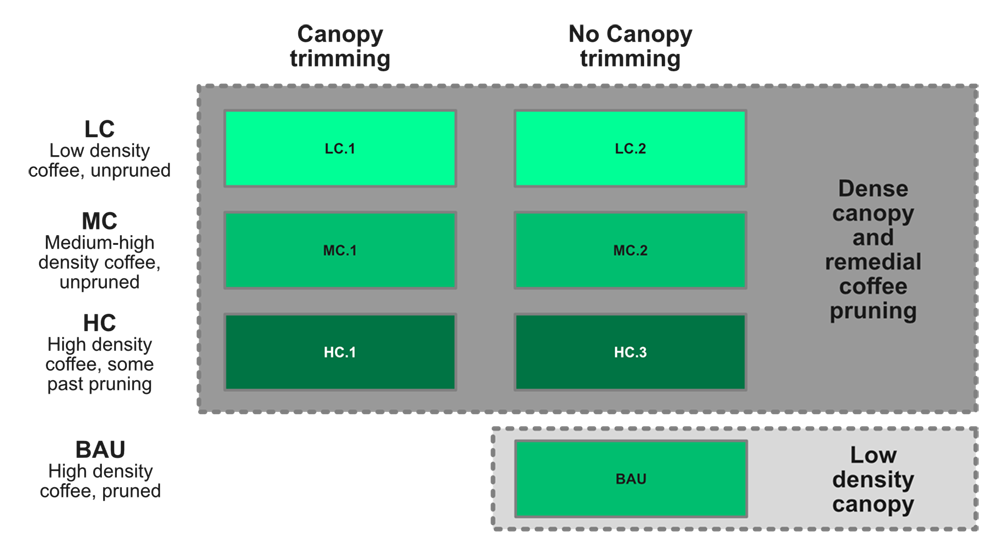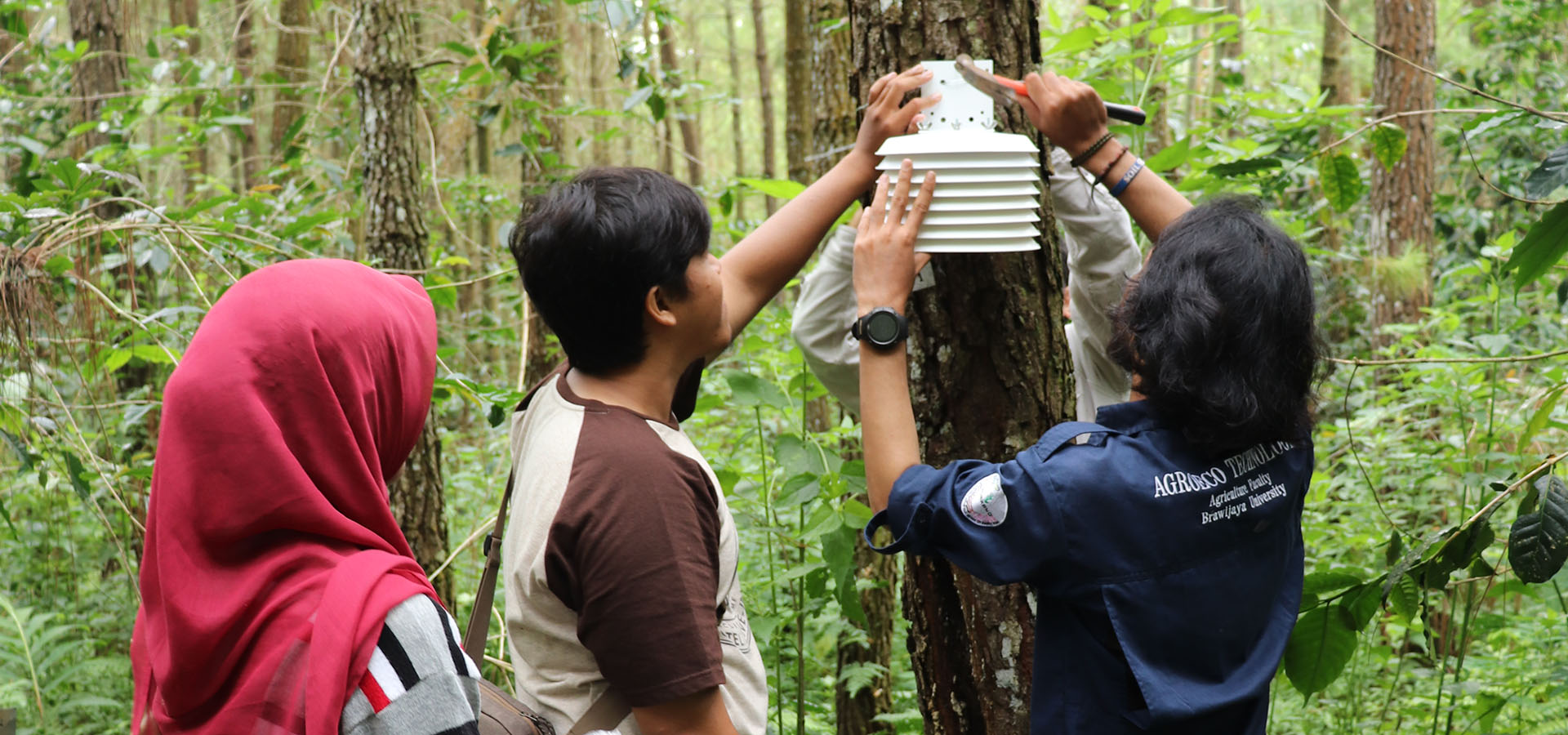The experimental platform provides facilities to compare different agronomic practices within UB forest, exploring impacts not only on coffee and timber production but also on a range of ecosystem services and processes.
Canopy thinning
UB Forest farmers identified shading as the primary constraint on coffee yields. Moderate shading can improve coffee quality and performance (1,2,3), however, shade levels within UB-forest are 30–40 % higher than this. Under the previous state forest management farmers were forbidden to remove any part of the pine trees. The UB management team allows for greater flexibility and, in consultation with farmers, we are trialling pine canopy trimming as a method to increase light levels whilst avoiding the need to fell trees.
We are combining this canopy thinning work with remedial coffee pruning. Coffee pruning is essential for maximising yield, but, it has been neglected in large areas of UB Forest due to a combination of farmer’s lack of agronomic knowledge and low motivation due to the sub-optimal conditions in which the coffee is grown.
The Platform
The main experimental platform consists of three large plots spanning a gradient of coffee management intensity (4) (Fig 1). The pine canopy has been trimmed in one half of each of these plot. This will allow us to understand the impact of the trimming over many years by comparing the trimmed and untrimmed half of each plot. This is important in studies of coffee as yields can vary from season to season.
Within these plots we are also exploring coffee pruning techniques. Like the trimming, this will allow us to understand, and demonstrate to the farmers, the yield impacts of pruning and canopy thinning both singularly and in combination.
A fourth productive ‘exemplar’ plot is also being monitored. This plot represents the most optimal growing conditions currently available within the forest. Being located in a small area with a lower density of pine trees, it provides a benchmark for comparing the success of the agronomic intervention. We also have smaller experimental areas adjacent to the main experimental plots where we are trialling different coffee pruning methods and fertilisers to benefit coffee productivity.

Layout of the pine trimming and coffee pruning platform. There are 3 paired plots - LC1 & 2, MC1 & 2, HC1 & 2, under a dense pine canopy, each 20 m wide by 60 m long and located side by side (on the 20 m edge). The pine canopy over plots numbered 1 has been trimmed, while the canopy over plots numbered 2 is untrimmed. The level management of the coffee gradually improves across the three pairs: LC1 and 2: low density coffee, very minimal management. MC1 and 2: Medium to high density coffee, with some management – weeding and fertilisation. HC1 and 2: High density coffee, with regular weeding and fertilisation, and some past pruning. The coffee in these plots has now been subject to remedial pruning, although in each plot a few areas (~20 m2) have been left unpruned for comparison. There is one additional unpaired plot - B.A.U. (business as usual / best local practice) containing high density, pruned coffee under a lower density pine canopy.
Measurements
Within the plots, the location, size and condition of every tree and coffee plant has been recorded (4) and each plant is identified with a permanent label. Microclimate sensors are being used in all plots either continually or on a campaign basis to measure soil moisture and temperature, light levels, air temperature and humidity levels.
Before and after trimming we measured canopy cover and we collected data on the mass of removed material (branches), along with the labour cost and hours required to conduct the trimming. Measurements of coffee yield (5) (flowering, bean set and harvest) are ongoing, and we have conducted assessments of pest and disease occurrence, natural predator abundance and understory plant diversity (6). An assessment of above and below ground carbon storage is being carried out together with a study on the impacts of trimming of pine roots growth.
Additional projects are continually being set up within and outside the main plots, to date these included studies of litter decomposition, fertiliser trials, studies of microbial biomass and earthworm abundance, as well as a study on different coffee pruning techniques.
References
- Caudill, S. A., DeClerck, F. J. A., & Husband, T. P. (2015). Connecting sustainable agriculture and wildlife conservation: Does shade coffee provide habitat for mammals? Agriculture, Ecosystems & Environment, 199, 85–93. View publication on web
- Jezeer, R. E., Santos, M. J., Boot, R. G. A., Junginger, M., & Verweij, P. A. (2018). Effects of shade and input management on economic performance of small-scale Peruvian coffee systems. Agricultural Systems, 162, 179–190. View publication on web
- Noponen, M. R. A., Edwards-Jones, G., Haggar, J. P., Soto, G., Attarzadeh, N., & Healey, J. R. (2012). Greenhouse gas emissions in coffee grown with differing input levels under conventional and organic management. Agriculture, Ecosystems & Environment, 151, 6–15. View publication on web
- Andika, T. R., & Wicaksono, K. P. (2020). Karakter Fisiologi dan Pertumbuhan Tanaman Kopi Arabika (Coffea arabica) pada Manajemen yang Berbeda di Lahan Agroforestri / Characteristics of Physilogy and Growth of Arabica Coffee (Coffea arabica) Plants in Different Management in Agroforestry Fields, Journal Produksi Tanaman. 8(2), 106–111. View publication on web
- Fardiansyah, I., & Wicaksono, K. P. (2019). Respon Pertumbuhan dan Produksi Tanaman Kopi (Coffea arabica) pada Tingkat Manajemen Budidaya yang Berbeda dalam Sistem Agroforestri / Growth and Production Response of Coffee Plants (Coffea arabica) at Different Levels of Cultivation Management in Agrofore. Jurnal Produksi Tanaman, 7(11), 2053–2060. View publication on web
- Zaahir, A. I., & Wicaksono, K. P. (2019). Analisis Biodiversitas di Bawah Tegakan Kopi Arabika (Coffea arabica) dan Pinus (Pinus densiflora) dengan Perbedaan Manajemen Agroforestri / Analysis of Biodiversity Under Arabica Coffee Stands (Coffea arabica) and Pine (Pinus densiflora) with Differences in Agroforestry Management. 7(12), 2196–2205. View publication on web
